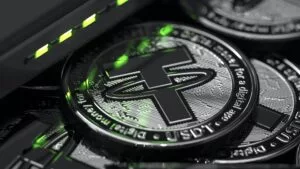
What are Stablecoins?
If you have spent any time researching cryptocurrencies, then you may have come across the term stablecoin. This word can cause some confusion for those new to cryptocurrencies. A commonly asked question is “Are stablecoins and cryptocurrencies the same thing?” The short answer is stablecoins are closely related to crypto coins, but there are some key differences. This article will look at what exactly stablecoins are. We will also discuss why they are worth buying.
What are stablecoins?
A stablecoin is a type of cryptocurrency that tries to avoid the volatility of the crypto market. To achieve this, stablecoins attach themselves to real world assets, like a fiat currency (e.g., the Canadian Dollar), gold, silver, oil, etc. The assets are held in reserve as collateral. The collateral acts as proof that the coin is pegged to an asset. Otherwise, users would distrust the stablecoin and its price would fall. As the stablecoin owner spends their token, an equal amount is withdrawn from the asset reserve. Because stablecoins are tied to a traditional asset, their value should remain the same. For example, a stablecoin worth one U.S. dollar should maintain that price regardless.
Since they are pegged to real life assets, stablecoins act like the common currencies used by people on a daily basis. Financial experts view stablecoins as the bridge between the crypto market and traditional assets: they have the decentralized nature and security of cryptocurrencies while having the stability of traditional currencies.

The top stablecoins by market value as of August 3, 2022. Source: CoinMarketCap
There are three types of stablecoins:
- Fiat-collateralized: These are stablecoins tied to real world currencies, like the U.S. or Canadian dollar. Other commodities like gold and oil can also be used as collateral for a stablecoin. Fiat-collateralized stable coins are regulated by independent third parties to ensure compliance.
- Crypto-collateralized: These stablecoins are backed by a cryptocurrency. Since cryptocurrencies are highly volatile, a large amount of crypto coins are held in reserve. Crypto-collateralized stablecoins use the blockchain to establish the serves. This means there is no governing body regulating the stablecoin.
- Non-collateralized: These stable coins have no asset reserves. Instead, they use a working mechanism to maintain a stable price. For example, Basecoin uses a consensus mechanism to increase or decrease the supply of the coin as needed. This mechanism acts like a central bank printing off bank notes to maintain a currency’s value.
A popular stablecoin is Tether, the first one ever created. Tether has become the largest stablecoin based on markety value ($85.03 billion CAD as of August 3, 2022). Tether is pegged to the U.S. dollar along with other assets like short-term deposits and commercial paper. As of August 3, 2022, the price for one Tether coin is $1.29 CAD (Canadian dollar). USD Coin is another popular stablecoin attached to the U.S. dollar. At the moment, one USD Coin is also worth 1.29 CAD. The price of each coin has not fluctuated greatly, only by a few cents.
Why are stablecoins worth it?
Overall, stablecoins are worth the purchase because of their effectiveness as a currency. Cryptocurrencies like Bitcoin do not function well as an everyday currency because their market value fluctuates greatly, sometimes by thousands of dollars in a single day. Since stablecoins are far less volatile, they work much better as an everyday currency.
This graph demonstrates that stability of Tether’s price over one year (August 3, 2021- August 3, 2022). Source: Binance.
Stablecoins are useful when trading for cryptocurrencies. Using traditional payment methods like a debit/credit card can result in expensive fees and additional charges. Additionally, the transfer time may be long. Using stablecoins for crypto transactions can be much quicker. Exchanges will still charge a fee, but it will not be as high if you used a traditional payment method.
For the most part, stablecoins are unaffected by downturns in the crypto market. Therefore, stablecoins are often used by investors to store the value of their more volatile crypto assets during a market crash. It is a useful strategy to avoid huge losses. For example, you could convert most of your Bitcoin into Tether. The stablecoin will hold the value as the crash runs its course. Once the market begins to recover, you can convert the value back to Bitcoin.
How to buy stableocins
Buying stablecoins is the same as buying other cryptocurrencies. To start, you will need a crypto wallet. You will have choice between a hardware or digital wallet. We recommend you go with a hardware wallet because they are more secure. Next, decide where you want to buy stablecoins. Cryptocurrency exchanges like Binance or Coinbase are commonly used platforms. Peer-to-Peer networks let you trade directly with another person for stablecoins. Once, you have picked a platform, you can start buying stablecoins. Most sites accept traditional payment methods like a debit/credit card. Exchanges will also let you use cryptocurrencies to make purchases (e.g., Bitcoin for Tether). Once your transaction has gone through, transfer the coins to your crypto wallet.
Frequently asked questions about stablecoins
How many stablecoins are there?
According to 101 Blockchains, there were almost 200 stablecoins on the crypto market in 2021. This demonstrates that the stablecoin market is healthy, diverse, and expanding. Out of this large pool, Tether, USD Coin, and Binance USD rank as the most valuable stablecoins based on market capitalization.
Are stablecoins safe?
Overall, stablecoins are safe. They are run on blockchain, which is a digital ledger that stores and records transactions. Because blockchain is difficult to hack, stablecoin is safe from thefts. However, the stability of stablecoins has come into question. The concern is that some stablecoins might not be fully backed by real life asset, despite their claims otherwise. Another concern is that some stablecoins will be unable to maintain their attachment to a traditional asset. This is often referred to as losing a peg.
A recent example of a stablecoin losing its peg happened with terraUSD. On May 7, terraUSD’s value had reached approximately $18 billion. Then, on May 9, terraUSD broke its peg to the U.S. dollar. This caused the price to drop from $1 USD down to ₵35 USD. This price drop caused the coin’s companion token LUNA to fall as well. By May 12, LUNA went from $80 USD down to a few cents, a lose of 96%. Eventually, LUNA collapsed completely. The two tokens were relaunched as TerraClassic and Terra 2.0. The collapse of terraUSD and LUNA affected the entire cryptocurrency market. Several coins like Bitcoin and Ethereum fell in price.
Since then, some cryptocurrencies are starting to recover. But the example still demonstrates stablecoins can sometimes falter.
Are stablecoins a good investment?
Stablecoins are not the best investment option. The stability of the coins means there is hardly any room for growth, which results in a lower chance of earning a profit from your investment. Stablecoins are best suited for crypto transactions and converting real currencies to crypto and vice versa.
What is an altcoin?
You may have seen the term altcoin pop up when researching stablecoins. So, what are they? Altcoins are all cryptocurrencies other than Bitcoin. They share similarities with Bitcoin but have their own characteristics. For example, Bitcoin uses the proof of work mechanism to create bocks and confirm new transactions. Some altcoins, like Ethereum, use proof of stake, which is a more efficient and eco friendly.
Altcoins come in several different categories. Stablecoins are one of them. The other categories are:
- Mining-based coins: These are cryptocurrencies that are created through the mining process. Some common mined altcoins include Litecoin, Monero and Ripple’s XRP.
- Security tokens: These are devices used to confirm a person’s identity digitally by storing a piece of personal identification. The user enters the security token into a system to gain access to a network service. Security token can come in hardware forms like USB sticks, or they can be digital like virtual coins.
- Meme coins: Meme coins are the comedy relief of the crypto market. They are often based on online jokes and serve as a parody of cryptocurrencies. The most famous example of a meme coins is Dogecoin. This cryptocurrency was inspired by the popular Doge meme. Shiba Inu is another popular meme coin; it is seen as Dogecoin’s rival.
- Utility tokens: According to Investopedia, utility token are used to buy services, pay network fees, or redeem rewards within a network. A commonly used utility coin is Filecoin; it is used to buy storage space on a network.
For more information on stablecoins, check out this video by 99Bitcoins:
Read more

The Best Credit Cards in Canada
Low interest? No fee? Cash back? Find the ideal credit card for your situation.

The Best Crypto Wallets in Canada
If you want to start trading crypto, then you’ll need a crypto wallet.

The Best Cryptocurrency Exchanges in Canada
Binance, Bitbuy, BitTrex and more: check the top crypto exchanges in Canada.

TFSA vs RRSP: Comparing the Two
A TFSA and RRSP are two ways to save money. This article will compare the two accounts.